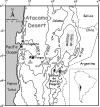Bacterial community structure in the hyperarid core of the Atacama Desert, Chile
- PMID: 17028238
- PMCID: PMC1694221
- DOI: 10.1128/AEM.01305-06
Bacterial community structure in the hyperarid core of the Atacama Desert, Chile
Abstract
Soils from the hyperarid Atacama Desert of northern Chile were sampled along an east-west elevational transect (23.75 to 24.70 degrees S) through the driest sector to compare the relative structure of bacterial communities. Analysis of denaturing gradient gel electrophoresis (DGGE) profiles from each of the samples revealed that microbial communities from the extreme hyperarid core of the desert clustered separately from all of the remaining communities. Bands sequenced from DGGE profiles of two samples taken at a 22-month interval from this core region revealed the presence of similar populations dominated by bacteria from the Gemmatimonadetes and Planctomycetes phyla.
Figures



References
-
- Altschul, S. F., W. Gish, W. Miller, E. W. Myers, and D. J. Lipman. 1990. Basic local alignment search tool. J. Mol. Biol. 215:403-410. - PubMed
-
- Arroyo, M. T. K., C. Castor, C. Marticorena, M. Muñoz, L. Cavieres, O. Mathei, F. Squeo, M. Grosjean, and R. Rodríguez. 1998. The flora of Llullaillaco National Park located in the transitional winter-summer rainfall area of the northern Chilean Andes. Gayana Botánica 55:93-110.
-
- Ausubel, F. M., R. Brent, R. E. Kingston, D. D. Moore, J. G. Seidman, J. A. Smith, and K. Struhl (ed.). 1995. Current protocols in molecular biology, p. 2.7.3-2.7.6. John Wiley & Sons, Inc., Hoboken, N.J.
-
- Betancourt, J. L., C. Latorre, J. A. Rech, J. Quade, and K. A. Rylander. 2000. A 22,000-year record of monsoonal precipitation from northern Chile's Atacama Desert. Science 289:1542-1546. - PubMed
-
- Chanal, A., V. Chapon, K. Benserara, M. Barakat, R. Christen, W. Achouak, F. Barras, and T. Heulin. 2006. The desert of Tataouine: an extreme environment that hosts a wide diversity of microorganisms and radiotolerant bacteria. Environ. Microbiol. 8:514-525. - PubMed
Publication types
MeSH terms
Substances
Associated data
- Actions
- Actions
- Actions
- Actions
- Actions
- Actions
- Actions
- Actions
- Actions
- Actions
- Actions
Grants and funding
LinkOut - more resources
Full Text Sources
Molecular Biology Databases

